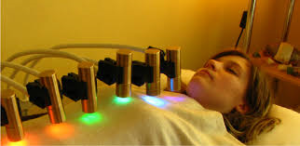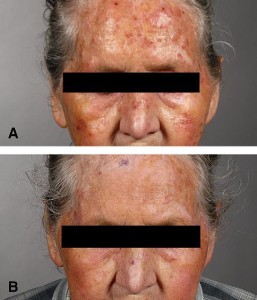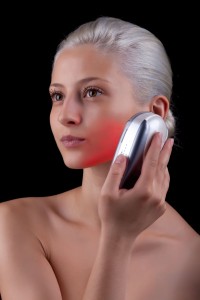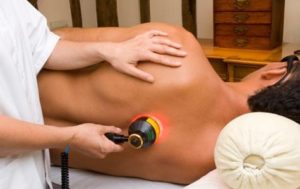 Red Light Therapy, Blue Light Therapy, Near-Infrared Light Therapy and Far-Infrared Light Therapy
Red Light Therapy, Blue Light Therapy, Near-Infrared Light Therapy and Far-Infrared Light Therapy
Some of the most common types of light therapy you’ll find used are red light therapy, blue light therapy, and infrared light therapy (either near- or far-infrared). While there is some debate over which wavelength is best, it’s generally becoming clear that certain wavelengths are best for certain conditions. If you were thinking of trying light therapy, you would first want to decide what result you are trying to achieve. Then you would select the wavelength and type of light believed to be effective for that condition (based on the research available).
Red and near-infrared light wavelengths can penetrate anywhere between one to six inches deep (scientists don’t agree on how deep). While scientists do not know for certain how light therapy works, there are theories. One popular view is that the light triggers the cell to make more energy (ATP) and increases DNA and RNA activity.
Some believe that this beneficial energy effect only occurs if the cell is damaged. This idea makes sense because it is usually damaged or diseased cells that one is trying to treat. However, light therapy could also have benefits for healthy cells.
Which Type of Light to Use: LED’s, Sunlight, Infrared, Etc.
The type of light that is best depends on your condition and what effect you are trying to achieve.
Sunlight is one type of light people use for light therapy. Sunlight may be chosen to increase vitamin D levels or improve fibromyalgia symptoms, for example. While sunlight can be very bright (and therefore very powerful), not everyone has access to full, bright sunlight year-round. When a more powerful light is needed, or when sunlight is not sufficiently available, another light source can be chosen. Usually, the choice is LED’s (light emitting diodes).
LED’s are by far the most popular light source used for red light therapy and blue light therapy. There are many reasons for this, but the most important one is that LED’s are capable of producing extremely bright, powerful (and therefore effective) light. Despite being extremely bright, LED’s require little energy and do not get as hot as other types of lighting. So using LED’s can be practical and also save on energy and costs. LED’s, because they’re stronger, can get the same effects faster than other light sources.
Other types of light can be used for different types of light therapy. For some conditions, these types are actually better than LED’s. An example might be using a halogen or fluorescent bulb.
What about Halogen Lights for Light Therapy?
Halogen lights put off light with a mixture of wavelengths. This “mix” is not that different from regular sunlight- it’s in the 600 to 900 nm range. This type of light can be effective and inexpensive, but it is not ideal for most applications. That is because the light it produces is not concentrated in the specific wavelengths known to be ideal/most effective.
Halogen can still have beneficial effects, however. For instance, some users of halogen light claim it temporarily reduced pain and irritation from injury. At least one other claim I’ve seen is that exercising in front of a halogen light burned more calories.
Infrared Light Therapy
Red light therapy for pain is not a new idea- people have been using infrared light for quite some time. It was believed that the heat the lamp produced was what helped so much. Now it is known that near-infrared light plays a role in relieving pain.
How Much Can Light Therapy Help Me?
There are a lot of factors in determining how much light therapy might help you: your condition, power of light used, source of light and more.
Light therapy is a very useful tool for some purposes, but it is not a magic cure-all. It is usually best used in addition to other treatments or therapies. For instance, if you are using light therapy to relieve pain, you might also apply ice and take an over-the-counter pain reliever. Light therapy should never be used as a substitute for professional medical care.
If you are using red light therapy for acne, you’d probably get maximum benefit from using it in addition to other treatments, such as topical antioxidant or anti-acne creams.
Results vary from person to person, but to give you an idea, some people say that after using light therapy for pain, their pain is reduced by 50-75%. The pain relief is temporary and usually lasts 4-6 hours. However, it is believed that using light therapy could help the injury actually heal faster.
If you have pain or a potentially serious injury, be sure to seek medical advice first!
What Wavelengths Should I Use?
The wavelength and type of light you choose depend on the results you are trying to achieve. Generally speaking, the most effective wavelengths of light are specific ranges:
- 610 to 625 nm
- 660 to 690 nm
- 750 to 770 nm
- 815 to 860 nm
How Much Light Therapy Should I Do?
When it comes to light therapy, more is not better. Doing light therapy treatments too much can cancel out the benefits you receive and depending on the type and source of light, it could also cause harm. For instance, in the case of sunlight or UV light therapy, more is not better.
If you are using light therapy for a condition that causes pain, it’s advised that you use it only long enough to cause a reduction in pain. This helps ensure you don’t overuse it and only use it enough to get the optimal result. The pain relief experienced is usually temporary and you will have to treat the area again in a few hours if pain persists. However, light therapy treatments are likely to help reduce healing time.
What’s difficult is determining how much light therapy is “too much”. That depends on the type of light source, the strength of the light, type of light, where the injury/condition is located on the body, etc. But because too much could cancel out the benefits you can get, it’s always best to err on the side of too little.
There is some evidence that the more recent an injury, wrinkle or other problem is, the more light therapy will help. So if you have a choice, it may be best to begin using light therapy soon afterwards. But not too soon! If you’re treating an injury, it is best to let inflammation subside before doing red light therapy or other light therapies. The reason is that red light therapy and most other light therapies increase blood flow to the region. If an area is already swollen and inflamed, more blood flow is not going to feel good and it is unlikely to help. Once inflammation goes down (if applicable), light therapy is often used multiple times in a day (for example, two to four times for 10 minutes each). However, in no case should you begin light therapy for a medical condition or potentially serious injury without first seeking professional medical advice. It would also be wise to discuss your case and how light therapy might be helpful with your doctor.
How Deep Can Light Therapy Penetrate Through Skin?
There is much debate over how deep light therapy devices can penetrate through the skin. This is an important matter, because if the light cannot penetrate deep enough into the body, it cannot help with problems occurring there.
One thing that is generally accepted is that the power of a light source has a big impact on how far through the skin it can reach.
Some argue that even very strong light therapy devices can only reach 1” to 1.5” deep through the skin. That implies that light therapy cannot work for anything that is deeper than that, such as a joint that is not on the surface.
Others claim that light therapy devices can sometimes reach 3” to 6” through the body- even through the skull into the brain.



